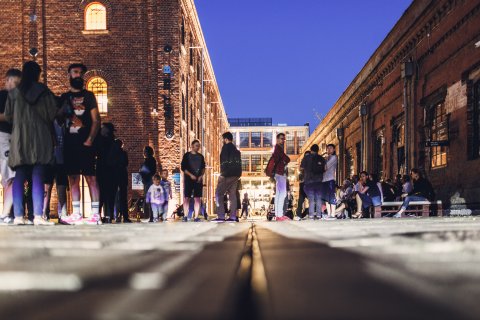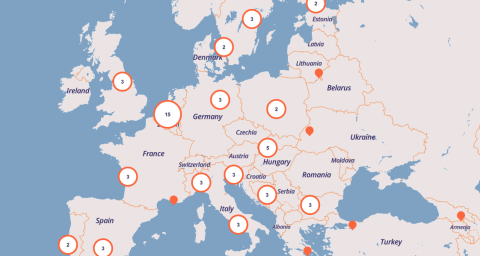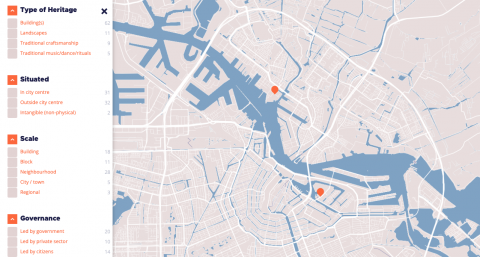Online atlas HUB-IN should inspire regeneration of historic urban areas

HUB-IN is a large-scale European project centred around the transformation of historic urban areas. HUB-IN (Hubs of Innovation and Entrepreneurship for the Transformation of Historic Urban Areas) aims to stimulate innovation and entrepreneurship in these historic urban landscapes, taking the unique cultural and social identity of these areas as its starting point. Recently, the researchers presented an online atlas. This shows the activities of more than 65 European initiatives, the finance and business models they’ve applied, how their governance structure is organised and what innovations they present in sustainable development, in a very accessible way. The atlas is a source of inspiration for similar and new initiatives in this field.
The HUB-IN atlas is meant for anyone interested in the redevelopment of historic urban areas. It is an online platform where you can filter your search, for example on type of heritage, the party that is in lead of the project, the financial resources that were used or on themes the various projects are connected with. For each project, there is a page with more information about the initiative, what it exactly is that they do and how they are organised. Dutch initiatives that are included are the NDSM-Werf (NDSM- wharf) and Marineterrein (the Navy Yard) in Amsterdam and Strijp-S in Eindhoven.
This way, we are trying to show the diversity of innovative and entrepreneurial initiatives that are there and make them accessible to others,
says Mara van Twuijver, researcher involved in the project. As researchers we are now going to make an analysis of all the cases in the atlas. Which elements in the ecosystem do they make use of, what are the differences between the cities and initiatives and what can other cities learn from this?

HUB-IN: regeneration of historical urban areas
Led by Lisboa E-Nova, a total of eight European cities and eighteen partners are working together on the HUB-In project, which has been made possible by a grant from the European Commission. The added value of the research project lies in the exchange of experiences and practices between the hubs in eight different European cities in Portugal, Great Britain, Cyprus, France, Italy, Romania, Slovenia and the Netherlands. In addition, all hubs cooperate intensively with various stakeholders in their local project: entrepreneurs, residents from the immediate vicinity and the local government. In addition, HUB-IN aims to create a broader European learning network on heritage-driven regeneration, which cities from outside the project can join as well.
The European Centre for Alternative Finance (ECAF) of the Utrecht University School of Economics (U.S.E.), CrowdfundingHub and the municipality of Utrecht jointly make an important contribution to HUB-IN from their expertise in the field of entrepreneurship and alternative finance. Apart from producing an inventory of all kinds of European regeneration projects, the research in Utrecht mainly focuses on the further development of the Entrepreneurial Ecosystem model. This model is the framework for the regeneration of the areas in the eight pilot cities.
Local context crucial for governance structure
The information in the atlas builds on our existing expertise in the field of entrepreneurial ecosystems,
says project leader Niels Bosma. Together with CrowdfundingHub and other project partners, we looked at how, as a local government or organisation, you can sound business and financing models for this type of project. The local context turns out to be crucial for the governance issues: the role of the public government, developers, real estate investors. This also plays a role in the Werkspoorkwartier in Utrecht: how do you ensure that the parties involved really have a say?
The financial and business model catalogue that Pieter van de Glind and Helen Toxopeus, together with other project partners, have developed, contains clear, insightful examples that we hope will inspire other cities.

We really hope to create a legacy that will last
Alliance of cities
In the coming months, the research team will continue to work on the development of a so-called dialogue tool that local players can use to think about the different types of value they want to create and that helps them in the development of balanced business models that represent the perspectives and interests of the various stakeholders. We would also like to test this in Utrecht,
says Bosma.
This dialogue tool will be available in May. In September, the team expects to present their final report on valuable entrepreneurial ecosystems for the regeneration of historic urban areas.
We really hope to create a legacy that will last,
says Bosma. We strive for an alliance of the cities that are participating in the current project - but which other cities can also join in the future.
Contact
Would you like to know more about this project? Please contact Mara van Twuijver: m.w.vantwuijver@uu.nl or Niels Bosma: n.s.bosma@uu.nl.

